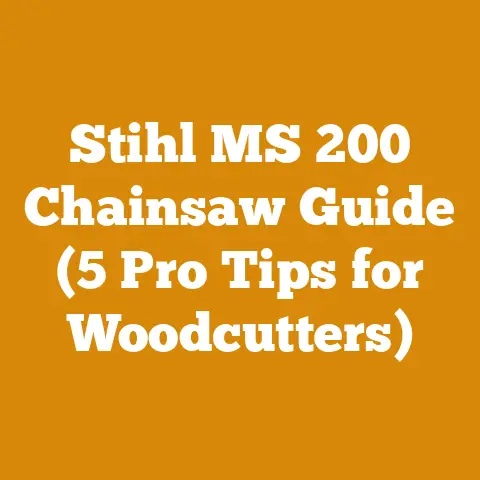Termite Nest on Tree: Impact on Wood Quality & Processing (Expert Insights)
Termite Nest on Tree: Impact on Wood Quality & Processing (Expert Insights)
The best-kept secret in the wood industry? It’s not about the perfect chainsaw or the mightiest log splitter. It’s about understanding the silent saboteurs: termites. Specifically, what happens when you stumble upon a termite nest inside a tree you’re planning to harvest. It’s a situation that can turn your carefully planned budget into a bonfire of wasted cash, and your beautifully envisioned woodworking project into a pile of sawdust. Let’s dive deep into the nitty-gritty of how termite nests impact wood quality and processing, and more importantly, how to protect your wallet.
My First Termite Encounter: A Costly Lesson
I still remember the day like it was yesterday. I was contracted to fell some mature oak trees for a local furniture maker. The trees looked healthy from the outside, majestic even. I had already factored in the usual challenges – potential hidden metal, difficult terrain, and the general unpredictability of felling large trees. What I didn’t factor in was a massive termite colony lurking within the heartwood of one of the oaks.
The telltale signs were there, in retrospect. A few small mud tubes snaking up the bark, some seemingly innocuous holes. But in my eagerness to get the job done, I overlooked them. The moment my chainsaw bit into the trunk, the truth was revealed. A cascade of sawdust mixed with… something else. Something that wriggled.
The tree was riddled with termite damage. The heartwood was essentially honeycomb, and much of the usable timber was compromised. The furniture maker refused the wood, and I was left with a partially processed log and a significantly lighter bank account. I had to pay for the disposal of the infested wood, and the missed opportunity cost stung. It was a costly lesson in the importance of thorough inspection and understanding the hidden enemies of wood.
Understanding the Enemy: Termites and Their Impact
Termites are social insects that feed on cellulose, the main structural component of wood. They live in colonies, often hidden within the wood itself, making detection difficult. The impact of a termite infestation on wood quality is multifaceted:
- Structural Weakness: Termites create tunnels and chambers within the wood, weakening its structural integrity. This is particularly problematic for load-bearing applications.
- Aesthetic Damage: The visible damage caused by termites, such as surface holes and galleries, can significantly reduce the aesthetic value of the wood.
- Increased Susceptibility to Decay: Termite damage creates entry points for moisture and fungi, accelerating the decay process.
- Reduced Yield: The amount of usable wood from an infested tree or log is significantly reduced, impacting the overall yield of a project.
Identifying Termite Infestation: Before You Cut
Prevention is always better (and cheaper) than cure. Before you even think about firing up your chainsaw, take the time to thoroughly inspect the trees you plan to harvest. Here are some key indicators of termite infestation:
- Mud Tubes: These are small, earthen tubes built by termites to travel between their nest and a food source. They are often found on the exterior of the tree trunk.
- Surface Holes: Small holes in the bark or wood surface can indicate termite activity.
- Soft Spots: Areas of the tree that feel soft or spongy to the touch may indicate internal damage.
- Frass: This is termite excrement, which looks like small pellets. It may be found near entry points or within the wood itself.
- Hollow Sounds: Tapping on the tree trunk may reveal hollow sounds, indicating internal damage.
- Swarming Termites: During certain times of the year, termites will swarm to reproduce. This is a clear sign of a nearby infestation.
Assessing the Damage: Is the Wood Salvageable?
Okay, you’ve identified a termite infestation. Now what? The next step is to assess the extent of the damage and determine if the wood is salvageable. This is where experience and a keen eye come in handy.
- Visual Inspection: Carefully examine the wood for visible damage, such as tunnels, galleries, and decay.
- Sounding: Use a hammer or mallet to tap on the wood. A solid sound indicates healthy wood, while a dull or hollow sound suggests damage.
- Probe Test: Use a sharp object, such as an awl or screwdriver, to probe the wood. If the tool penetrates easily, the wood is likely damaged.
- Moisture Meter: Use a moisture meter to check the moisture content of the wood. High moisture levels can indicate decay.
If the damage is localized and superficial, you may be able to salvage some of the wood by removing the affected areas. However, if the damage is extensive, the wood may be unusable for structural purposes. Remember, safety first. Severely compromised wood can be unpredictable and dangerous to work with.
The Cost of Termite Damage: A Breakdown
This is where things get real. Let’s break down the costs associated with dealing with termite-infested wood.
-
Lost Timber Value: This is the most obvious cost. If the wood is unusable, you lose the value of the timber itself. The price of timber varies significantly depending on the species, quality, and location. According to the US Forest Service, the average stumpage price (the price paid for standing timber) for sawtimber in the United States in 2023 was around \$300 per thousand board feet. However, prices can range from \$50 to \$1000 or more, depending on the species and quality. For example, black walnut can fetch upwards of \$1000 per thousand board feet, while pine may only be worth \$50.
- Example: Let’s say you were planning to harvest a walnut tree that would yield 500 board feet of lumber. At \$1000 per thousand board feet, the value of the timber would be \$500. If the tree is infested with termites and the wood is unusable, you lose that \$500.
-
Labor Costs: Felling, processing, and transporting termite-infested wood can be more time-consuming and labor-intensive than working with healthy wood. This can increase your labor costs significantly. According to data from the Bureau of Labor Statistics, the average hourly wage for logging workers in the United States in 2023 was around \$22. However, wages can vary depending on experience, location, and the type of work being performed.
- Example: If it takes you an extra 4 hours to fell and process a termite-infested tree, and your labor cost is \$22 per hour, that adds an extra \$88 to your costs.
-
Equipment Costs: Chainsaws, log splitters, and other wood processing equipment can be damaged by working with termite-infested wood. Termites can dull chainsaw chains quickly, and the weakened wood can cause equipment malfunctions. The cost of maintaining and repairing your equipment can add up quickly. A new chainsaw chain can cost anywhere from \$20 to \$50, and repairs to a log splitter can easily run into the hundreds of dollars.
-
Disposal Costs: Termite-infested wood cannot be used for firewood or other purposes. It must be disposed of properly to prevent the spread of the infestation. This can involve hauling the wood to a landfill or burning it in a controlled environment. Landfill fees vary depending on the location, but they can range from \$50 to \$100 per ton. Burning the wood may require permits and can be subject to environmental regulations.
- Example: If you have a ton of termite-infested wood to dispose of, and the landfill fee is \$75 per ton, that adds another \$75 to your costs.
-
Opportunity Costs: The time and resources you spend dealing with termite-infested wood could be spent on other, more profitable projects. This is known as opportunity cost. It’s the value of the next best alternative that you forgo when you choose to do something else.
- Example: If you spend a week dealing with termite-infested wood, and you could have spent that week working on a project that would have generated \$1000 in revenue, your opportunity cost is \$1000.
-
Treatment Costs: If the termite infestation is widespread, you may need to treat the surrounding area to prevent further damage. This can involve hiring a pest control company to apply insecticides or using other preventative measures. Termite treatment costs can vary widely depending on the size of the area being treated and the type of treatment used. According to data from HomeAdvisor, the average cost of termite treatment in the United States in 2023 was around \$560.
Budgeting for the Unexpected: A Contingency Plan
The key to managing the costs associated with termite damage is to be prepared. This means including a contingency plan in your budget to cover unexpected expenses. I typically add a 10-15% contingency to my wood processing budgets to account for unforeseen problems, including termite infestations.
Here’s how to create a contingency plan:
- Estimate Your Costs: Start by estimating the costs of your project, including timber purchase, labor, equipment, and disposal.
- Identify Potential Risks: Identify potential risks that could increase your costs, such as termite infestations, hidden metal, and difficult terrain.
- Estimate the Impact of Each Risk: Estimate the potential impact of each risk on your costs. For example, if you suspect that there is a 20% chance of encountering a termite infestation that could increase your costs by \$500, the expected cost of that risk is \$100 (20% of \$500).
- Add a Contingency: Add a contingency to your budget to cover the expected costs of the risks you have identified. A 10-15% contingency is a good starting point, but you may need to adjust it based on the specific risks associated with your project.
Optimizing Costs: Minimizing the Damage
While you can’t always prevent termite infestations, there are steps you can take to minimize the damage and optimize your costs:
- Thorough Inspection: As mentioned earlier, thorough inspection is crucial. Take the time to carefully examine the trees you plan to harvest for signs of termite infestation.
- Selective Harvesting: If you identify a termite infestation in one tree, consider harvesting other trees in the area first. This will allow you to minimize the risk of spreading the infestation.
- Proper Storage: Store your wood properly to prevent termite infestations. Keep wood off the ground, away from moisture, and in a well-ventilated area.
- Timely Processing: Process your wood as soon as possible after harvesting. This will reduce the risk of termite infestations and decay.
- Professional Advice: If you are unsure about how to deal with a termite infestation, seek professional advice from an arborist or pest control company.
Case Study: Saving Money on a Firewood Project
I once had a firewood preparation project where I suspected a termite issue in a pile of seasoned oak. Instead of just writing off the whole lot, I decided to get strategic.
First, I carefully inspected each piece, marking the ones with obvious signs of damage. Then, I used a moisture meter to check the moisture content of the questionable pieces. Termites thrive in damp wood, so drier pieces were less likely to be heavily infested.
Next, I split a few of the suspect logs to examine the inside. Luckily, the infestation was limited to the outer layers in most cases. I was able to salvage a significant portion of the wood by simply removing the damaged sections.
I ended up saving about 60% of the firewood I would have otherwise discarded. Yes, it took extra time and effort, but it was well worth it in the end. The key was to approach the problem systematically and use the right tools and knowledge.
The Chainsaw Choice: An Important Factor
The chainsaw you use can also impact your costs when dealing with potentially infested wood. A sharp, high-quality chainsaw will cut through wood more efficiently and reduce the risk of kickback or other accidents. I prefer using a chainsaw with a chain that is specifically designed for cutting dirty or contaminated wood, as this will help to prolong the life of the chain.
Consider these factors when choosing a chainsaw for wood processing:
- Engine Size: A larger engine will provide more power and allow you to cut through thicker wood more easily.
- Bar Length: The bar length should be appropriate for the size of the trees you are felling.
- Chain Type: Choose a chain that is appropriate for the type of wood you are cutting.
- Safety Features: Look for chainsaws with safety features such as chain brakes and anti-vibration systems.
Firewood Pricing: The Termite Factor
When selling firewood, it’s crucial to factor in the potential for termite damage. You can’t ethically sell infested wood, and you need to account for potential losses.
Here’s how I approach firewood pricing:
- Calculate My Costs: I start by calculating all my costs, including timber purchase, labor, equipment, and transportation.
- Estimate My Yield: I estimate the amount of firewood I will be able to produce from a given amount of timber.
- Factor in Losses: I factor in potential losses due to termite damage, decay, and other factors.
- Add a Profit Margin: I add a profit margin to cover my overhead and provide a return on my investment.
- Set My Price: I set my price based on my costs, yield, losses, and profit margin.
The price of firewood varies significantly depending on the location, species, and quality. According to data from the US Energy Information Administration, the average price of firewood in the United States in 2023 was around \$250 per cord. However, prices can range from \$150 to \$400 or more, depending on the location and quality.
Calculations and Formulas: Estimating Wood Volume
Accurately estimating the volume of wood you are harvesting is essential for budgeting and pricing. Here are some common formulas for estimating wood volume:
-
Board Feet: A board foot is a unit of measurement equal to 144 cubic inches. The formula for calculating board feet is:
(Thickness in inches x Width in inches x Length in feet) / 12
-
Cords: A cord is a unit of measurement equal to 128 cubic feet. The formula for calculating cords is:
(Length in feet x Width in feet x Height in feet) / 128
-
Doyle Log Scale: The Doyle Log Scale is a common method for estimating the board foot volume of a log. The formula is:
((Diameter in inches - 4) / 4)^2 x Length in feet
These formulas are just approximations, and the actual volume of wood you harvest may vary. However, they can be useful for estimating your costs and potential revenue.
Actionable Takeaways and Next Steps
Dealing with termite-infested wood is a challenge, but it’s one that can be managed with careful planning and a proactive approach. Here are some actionable takeaways and next steps:
- Educate Yourself: Learn to identify the signs of termite infestation and understand the impact of termites on wood quality.
- Inspect Thoroughly: Take the time to carefully inspect the trees you plan to harvest for signs of termite infestation.
- Create a Contingency Plan: Include a contingency plan in your budget to cover unexpected expenses, such as termite damage.
- Optimize Your Costs: Take steps to minimize the damage and optimize your costs, such as selective harvesting and proper storage.
- Seek Professional Advice: If you are unsure about how to deal with a termite infestation, seek professional advice from an arborist or pest control company.
By following these steps, you can protect your wallet and ensure the success of your wood processing or firewood preparation projects.
Final Thoughts: A Global Perspective
Termite infestations are a global problem, affecting woodworkers and loggers in every corner of the world. The challenges faced by small-scale loggers, firewood suppliers, and independent wood processors are particularly acute, as they often lack the resources to deal with termite damage effectively.
By sharing knowledge and best practices, we can help these individuals overcome the challenges posed by termites and ensure the sustainable use of wood resources worldwide. Remember, knowledge is power, and a little bit of foresight can go a long way in protecting your investment.
So, the next time you’re out in the woods, keep an eye out for those silent saboteurs. A little bit of vigilance can save you a whole lot of trouble – and money – in the long run. Happy woodworking!






